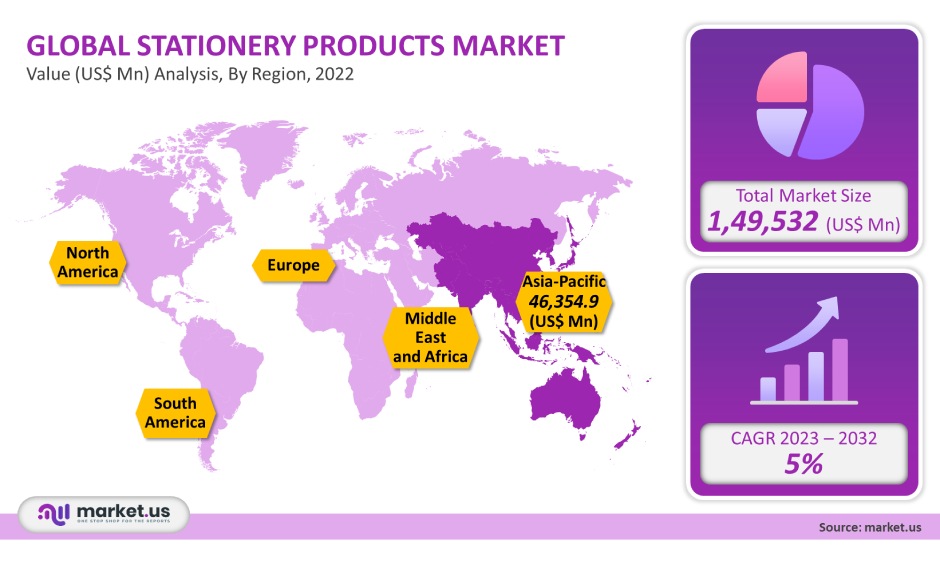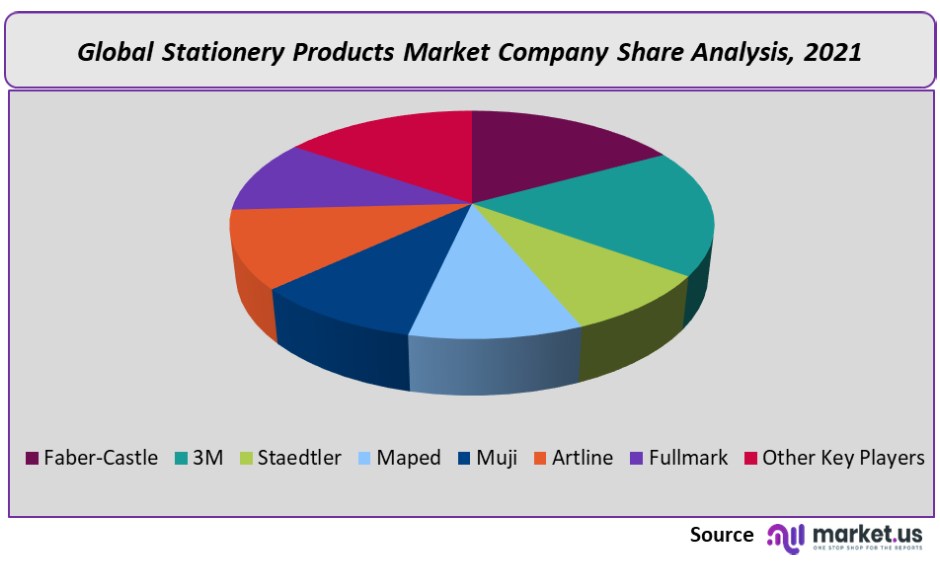Global Stationery Products Market By Type (Stapler, Pen, Diary, and Other), By Application (Household, Commercial, Office, and Other), By Region, and Key Companies - Industry Segment Outlook, Market Assessment, Competition Scenario, Trends and Forecast 2020-2029
- Published date: May 2023
- Report ID: 50450
- Number of Pages: 357
- Format:
- keyboard_arrow_up
Quick Navigation
Report Overview
The global Stationery Products Market size is valued at USD 1,49,532 million in 2021. It is projected to grow at a compound annual growth rate (CAGR), of 5% over the forecast time. Market growth can be attributed to rising literacy rates worldwide and a rising number of youth who are interested in higher education. The rapid rise of startups is another factor driving the market growth. According to NASSCOM in 2018, more than 1200 start-ups were established. These sectors are proving to be a key driver of market growth by increasing employment. Government initiatives have resulted in an increase in schools and colleges in rural and urban areas. This is directly impacting market development.
Global Stationery Products Market Scope:
Application analysis
Market segments are further based on application: educational institutes and corporates. With a 45.3% share in 2021, educational institutions dominated the market. The segment’s growth is due to the increasing number of schools, colleges, and a growing populace.
Apart from digitization and the cost of installing smart classes, it is also costly and impossible for some institutions to afford. Thus, there is a constant increase in demand for stationery products. The region’s growing interest in studying abroad is also affecting the market growth, ultimately fueling the overall market growth. According to the U.S. embassy report in 2017, there was a 12.0% rise in Indian students. In contrast, the CAGR for the corporate sector will be 5.3% during the forecast period. Despite the digitization of the corporate sector, paper still remains the dominant stationery product that is used in the sector.
Product analysis
The market is divided by-products into paper-based, ink-based, Art Based, and Other product segments. The paper-based market accounted for 2021 for 31.4% and is expected to grow significantly in the near future. Even after digitization hit the markets, paper remains one of the most widely used stationery products. It is often used for printing. Paper usage is expected to increase with the opening of more coaching centers. For printing question papers and other assignment sheets in education, paper is used. Paper is used for many other purposes in government offices and architecture.

The forecast period sees an expected 5.7% CAGR in the ink-based market. The market growth is driven by the increasing demand for pens from millennials who have an increased interest in higher education. Innovation is another key factor in driving industry growth. The introduction of RGB pens which enable users to write any color has had a positive impact on the industry’s growth. Manufacturers created wooden pens in order to make their products eco-friendlier.
Кеу Маrkеt Ѕеgmеntѕ
By Product
- Paper Based
- Ink Based
- Art Based
- Others products
By Application
- Educational Institutes
- Corporates
- Other Applications
Market Dynamics:
The global education market is forecast to see significant growth, which will drive the market growth during the forecast period. The luxury pen market is growing because of increasing brand awareness, as well as the disposable income of consumers. This is causing a significant boost in the global industry’s growth in the forecast period.
Globalization is also important for market growth. It has led to the growth of multinational businesses in many countries. This influences the region’s market growth. Numerous international companies have welcomed Indian government initiatives. Huawei, a Chinese firm, decided to invest in India as part of its Make in India strategy. This led to expansion.
These factors have helped India’s market growth and are expected to continue to fuel the industry’s growth during the forecast period. But, the industry will face challenges in the future due to rapid digitization. The market growth has been held back by green schooling and smart classes. However, there is still a perception that pen and notes are the best education. This will hinder the market’s growth in the near future.
Regional Analysis
The Asia Pacific led the market in 2021 with a 31% share. This market is experiencing significant growth in 2021. India holds the largest share of APAC’s market and is expected to register a 6.2% compound annual growth rate (CAGR) over the forecast period. The regional market is expected to grow due to high demand for different types of stationery items and an increase in the number of educational institutes, both rural and urban.
Africa and the Middle East will experience the fastest growth at 6.1% during the forecast period. The region’s industrial growth has been due to increased awareness of education in the Middle East and encouraging women to further their education. The region’s market growth is due to an increase in school numbers in African regions. This can be attributed to both government initiatives and international donations.

Key Regions and Countries covered іn thе rероrt:
- North America
- US
- Canada
- Mexico
- Europe
- Germany
- UK
- France
- Italy
- Russia
- Spain
- Rest of Europe
- APAC
- China
- Japan
- South Korea
- India
- Rest of Asia-Pacific
- South America
- Brazil
- Argentina
- Rest of South America
- MEA
- GCC
- South Africa
- Israel
- Rest of MEA
Faber-Castle, 3M, Staedtler, and Muji are among the top players in the sector. A large number of unorganized players make it difficult to enter the market.
India is one of the countries where many consumers still prefer to buy stationery from local vendors than from large market leaders. These are some of the challenges the market presents to players. This varies from one country or the other. Advertising plays an important part in creating awareness of the product and in innovating with the product. Reynolds was the first to market pens with waterproof inks. These are the major players in the global Stationery Products industry.

Маrkеt Кеу Рlауеrѕ:
- Faber-Castle
- 3M
- Staedtler
- Maped
- Muji
- Artline
- Fullmark
- Reynolds Pens
- Linc Pens & Plastics Ltd
- Other Key Players
For the Stationery Products Market research study, the following years have been considered to estimate the market size:
Attribute Report Details Historical Years
2016-2020
Base Year
2021
Estimated Year
2022
Short Term Projection Year
2028
Projected Year
2023
Long Term Projection Year
2032
Report Coverage
Competitive Landscape, Revenue analysis, Company Share Analysis, Manufacturers Analysis, Volume by Manufacturers, Key Segments, Key company analysis, Market Trends, Distribution Channel, Market Dynamics, COVID-19 Impact Analysis, strategy for existing players to grab maximum market share, and more.
Regional Scope
North America, Europe, Asia-Pacific, South America, Middle East & Africa
Country Scope
United States, Canada and Mexico, Germany, France, UK, Russia and Italy, China, Japan, Korea, India and Southeast Asia, Brazil, Argentina, Colombia etc.Saudi Arabia, UAE, Egypt, Nigeria and South Africa
Frequently Asked Questions (FAQ)
Q: What is the size of the Stationery Products market in 2021?The Stationery Products market size is US$ 1,49,532 million in 2021.
Q: What is the projected CAGR at which the Stationery Products market is expected to grow at?The Stationery Products market is expected to grow at a CAGR of 5% (2023-2032).
Q: List the segments encompassed in this report on the Stationery Products market?Market.US has segmented the Stationery Products market by geographic (North America, Europe, APAC, South America, and Middle East and Africa). By Product, market has been segmented into Paper, Based, Ink Based, Art Based and Others products. By Application, the market has been further divided into Educational Institutes, Corporates and Other Applications.
Q: List the key industry players of the Stationery Products market?Faber-Castle, 3M, Staedtler, Maped, Muji, Artline, Fullmark and Other Key Players, are the key vendors in the Stationery Products market.
Q: Which region is more appealing for vendors employed in the Stationery Products market?APAC accounted for the highest revenue share of 31%. Therefore, the Stationery Products industry in APAC is expected to garner significant business opportunities over the forecast period.
Q: Name the key areas of business for Stationery Products?The US, China, Japan, India, Brazil, Germany, UK, France, Italy, Spain, etc., are key areas of operation for Stationery Products Market.
Q: Which segment accounts for the greatest market share in the Stationery Products industry?With respect to the Stationery Products industry, vendors can expect to leverage greater prospective business opportunities through the Educational institutes and Corporates segment, as this area of interest accounts for the largest market share.

- Faber-Castle
- 3M Company Company Profile
- Staedtler
- Maped
- Muji
- Artline
- Fullmark
- Reynolds Pens
- Linc Pens & Plastics Ltd
- Other Key Players
- settingsSettings
Our Clients
| Single User $4,599 $3,499 USD / per unit save 24% | Multi User $5,999 $4,299 USD / per unit save 28% | Corporate User $7,299 $4,999 USD / per unit save 32% | |
|---|---|---|---|
| e-Access | |||
| Report Library Access | |||
| Data Set (Excel) | |||
| Company Profile Library Access | |||
| Interactive Dashboard | |||
| Free Custumization | No | up to 10 hrs work | up to 30 hrs work |
| Accessibility | 1 User | 2-5 User | Unlimited |
| Analyst Support | up to 20 hrs | up to 40 hrs | up to 50 hrs |
| Benefit | Up to 20% off on next purchase | Up to 25% off on next purchase | Up to 30% off on next purchase |
| Buy Now ($ 3,499) | Buy Now ($ 4,299) | Buy Now ($ 4,999) |











